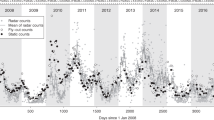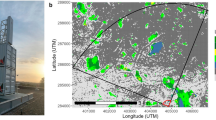Abstract
Context
Weather surveillance radars (WSR) have been used to locate roost sites used by Purple Martins (Progne subis) for decades. Improvements in radar data processing and accessibility now make it possible to monitor roosts over a broad spatial scale.
Objectives
We sought to locate all of the Purple Martin roosts in North America and to use the data to evaluate (1) the land cover types associated with roosts (2) relationships among roost persistence, land cover type, and regional population trends.
Methods
We used mosaicked images of radar reflectivity based on the NEXRAD WSR network to locate 234 Purple Martin roosts that were active between 2009 and 2014. Of these roosts, we ground-truthed a subset of 57 with site visits and reports from citizen scientists. We assigned roosts to different classes based on local land cover, and used a variety of statistical and spatial analyses to address the objectives listed above.
Results
Roosts were mainly associated with forest, cropland, urban, and water land cover types, with cropland being the most common. There was an apparent preference for urban sites, and urban roosts were associated with the high year-to-year persistence. We found no correlation between roost persistence and regional population trends in data from the North American Breeding Bird Survey (BBS).
Conclusions
Although they use a diverse array of roosting habitats, urban roosting areas appear to be increasingly important for Purple Martins. Persistence of urban roosts was high, which aligns with the species’ unique natural history and its association with human societies.





Similar content being viewed by others
References
Baddeley A, Turner R (2005) Spatstat: an R package for analyzing spatial point patterns. J Stat Softw 12(6):1–42
Brown CR (1997) Purple Martin (Progne subis). In: Poole A (ed), The birds of North America. Cornell Lab of Ornithology, Ithaca, NY. Available via http://bna.birds.cornell.edu/bna%29/species/287 doi:10.2173/bna.287
Burney CW (2002) A study of swallow roosts found in the Eastern United States. Cornell University, Ithaca
Chilson PB, Frick WF, Kelly JF, Howard KW, Larkin RP, Diehl RH, Westbrook JK, Adam Kelly T, Kunz TH (2011) Partly cloudy with a chance of migration: weather, radars, and aeroecology. B Am Meteorol Soc 93(5):669–686
Dray S, Dufour AB (2007) The ade4 package: implementing the duality diagram for ecologists. J Stat Softw 22(4):1–20
Drummond MA, Auch R (2014) Land-cover change in the United States Great Plains. Available via http://landcovertrends.usgs.gov/gp/regionalSummary.html. Accessed 23 Mar 2015
Drummond MA, Loveland TR (2010) Land-use pressure and a transition to forest-cover loss in the Eastern United States. Bioscience 60(4):286–298
Drummond MA, Auch RF, Karstensen KA, Sayler KL, Taylor JL, Loveland TR (2012) Land change variability and human-environment dynamics in the United States Great Plains. Land Use Policy 29(3):710–723
Fraser KC, Stutchbury BJM, Kramer P, Silverio C, Barrow J, Newstead D, Mickle N, Tautin J (2013) Consistent range-wide pattern in fall migration strategy of Purple Martin (Progne subis), despite different migration routes at the Gulf of Mexico. Auk 130:291–296
Gauthreaux SA Jr (2006) Bird migration: methodologies and major research trajectories (1945–1995). Condor 98:442–453
Jetz W, McPerson JM, Guralnick RP (2012) Integrating biodiversity distribution knowledge: toward a global map of life. Trend Ecol Evol 27(3):151–159
Kelly J, Shipley J, Chilson P, Howard K, Frick W, Kunz T (2012) Quantifying animal phenology in the aerosphere at a continental scale using NEXRAD weather radars. Ecosphere 3(2):16
Laughlin AJ, Taylor CM, Bradley DW, Leclair D, Clark RC, Dawson RD, Dunn PO, Norris DR (2013) Integrating Information from geolocators, weather radar, and citizen science to uncover a key stopover area of an aerial insectivore. Auk 130(2):230–239
Loveland TR, Acevedo W (2014) Land cover change in the Eastern United States. Available via http://landcovertrends.usgs.gov/east/regionalSummary.html. Accessed 23 Mar 2015
Natural Resources Canada, The Canada Centre for Mapping and Earth Observation, United States Geological Survey, Insituto Nacional de Estadística y Geografía (INEGI), Comisión Nacional para el Conocimiento y Uso de la Biodiversidad, Comisión Nacional Forestal (2010) North American land cover at 250 m spatial resolution
Omernik JM, Griffith GE (2014) Ecoregions of the conterminous United States: evolution of a hierarchical spatial framework. Environ Manage 54(6):1249–1266
Pettorelli N, Ryan S, Mueller T, Bunnefeld N, Jedrzejewsk B, Lima M, Kausrud K (2011) The Normalized difference vegetation index (NDVI): unforeseen successes in animal ecology. Clim Res 46:15–27
R Core Team (2014) A language and environment for statistical computing. R Foundation for Statistical Computing, Vienna, Austria. http://www.R-project.org/. Accessed 15 Nov 2014
Rajala T, Illian J (2012) A family of spatial biodiversity measures based on graphs. Environ Ecol Stat 19(4):545–572
Ray JD (1995) Purple Martins in northwest Texas. Purple Martin Update 6(3):10–12
Russell KR, Gauthreaux SA (1998) Use of weather radar to characterize movements of roosting purple martins. Wildl Soc Bull 26:5–16
Russell KR, Gauthreaux SA (1999) Spatial and temporal dynamics of a Purple Martin pre-migratory roost. Wilson Bull 111:354–362
Russell KR, Mizrahi DS, Gauthreaux SA (1998) Large-scale mapping of Purple Martin pre-migratory roosts using WSR-88D weather surveillance radar. J Field Ornithol 69(3):509–509
Sauer JR, Hines JE, Fallon JE, Pardieck KL, Ziolkowski DJ Jr, Link WA (2014) The North American breeding bird survey, results and analysis 1966–2013. USGS Patuxent Wildlife Research Center, Laurel, MD
Schimel D (2011) The era of continental-scale ecology. Front Ecol Environ 9(6):311
Tarof S, Brown CR (2013) Purple Martin (Progne subis). In: Poole A (ed) The birds of North America Online. Cornell Lab of Ornithology, Ithaca
Tautin J, Cousens B, Kostka K, Kotska S, Airola DA (2009) Addressing regional declines in Purple Martin populations. In: Rich T. D., Arizmendi C., Demarest D., Thompson C. (eds), Tundra to tropics: connecting birds, habitats and people. In: Proceedings of the fourth international partners in flight conference. Partners in Flight, McAllen, TX, pp 82–87
Tøttrup AP, Klaassen RH, Strandberg R, Thorup K, Kristensen MW, Jørgensen PS, Fox J, Afanasyev V, Rahbek C, Alerstam T (2012) The annual cycle of a trans-equatorial Eurasian–African passerine migrant: different spatio-temporal strategies for autumn and spring migration. Proc R Soc 279(1730):1008–1016
Wiegand T, Gunatilleke CVS, Gunatilleke IAUN, Huth A (2007) How individual species structure diversity in tropical forests. Proc Natl Acad Sci USA 104(48):19029–19033
Wilson A, Bonaparte CL, Jameson R, Ord G, Hetherington WM (1831) American ornithology; or the natural history of the birds of the United States. Constable and co., Edinburgh
Winkler DW (2006) Roosts and migrations of swallows. Hornero 21:85–97
Zhang J, Howard K, Langston C, Vasiloff S, Kaney B, Arthur A, Van Cooten S, Dempsey C (2011) National mosaic and multi-sensor QPE (NMQ) system—description, results and future plans. Bull Am Meteorol Soc. doi:10.1175/BAMS-D-11-00047.1
Acknowledgments
This study was funded by NSF-EAGER Grant 143210. We thank the Purple Martin Conservation Association for sharing their database of martin roost locations, and we thank Jacob van der Ploeg for ground-truthing martin roosts locations in Texas, Oklahoma, Arkansas, Missouri, and Kansas during the summer of 2012.
Author information
Authors and Affiliations
Corresponding author
Additional information
Special issue: Macrosystems ecology: Novel methods and new understanding of multi-scale patterns and processes.
Guest Editors: S. Fei, Q. Guo, and K. Potter.
Rights and permissions
About this article
Cite this article
Bridge, E.S., Pletschet, S.M., Fagin, T. et al. Persistence and habitat associations of Purple Martin roosts quantified via weather surveillance radar. Landscape Ecol 31, 43–53 (2016). https://doi.org/10.1007/s10980-015-0279-0
Received:
Accepted:
Published:
Issue Date:
DOI: https://doi.org/10.1007/s10980-015-0279-0




